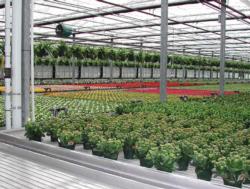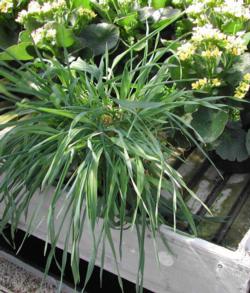Bedding Plant IPM in California
Implementation of IPM in California bedding and container color plant production
by Christine Casey and Michael Parrella
Within the environmental horticulture industry, bedding and container color plant producers provide much of the plant material used in and around homes and offices. These plants are produced and purchased year round for their aesthetic value, with an emphasis on flower color and shape, and clean, green foliage.
Given that several key pests can be expected to occur regularly on most plants in each crop, this can be a challenge (Figure 1). In addition, production of these plants in an 8 to 10-week crop cycle is typical, and most growers make their profits from quick turnovers of large numbers of plants. This leads to a low tolerance for pest injury and a perception that pesticide applications based on scouting or biological control are not appropriate.
It is not unusual for there to be one to three pesticide applications made weekly during the entire crop cycle, which represents significant costs in time, labor and pesticides. Although this industry is using increasing amounts of reduced-risk pesticides, there is still considerable use of “older” materials such as diazinon, chlorpyrifos, acephate, and malathion. Reducing the use of these materials, along with preserving water quality, is a focus of state and county regulatory agencies. All of these factors suggest it may be in growers’ interest to reconsider the use of integrated pest management (IPM) in bedding and color plant production.
To promote the adoption of IPM by this industry, under the direction of Dr. Parrella, we have formed a team of researchers, growers, extension staff and industry representatives to develop and implement bedding plant IPM demonstrations at collaborating growers’ operations.
Major funding for this work is from the Pest Management Alliance program of the California Department of Pesticide Regulation. Rather than a “one size fits all program,” we will work with individual collaborators to design a program tailored to each operation. Success of our demonstration projects will serve as a model that other growers can adapt to their operations.
Key elements of the IPM plan include pest monitoring to prioritize control measures, use of fast-acting biological control agents coupled with compatible pesticides, increased use of appropriate cultural controls and improved water management to reduce disease pressure. Our goal for the three-year project is to reduce overall pesticide use in the production of bedding and container color plants by 30%, and to reduce organophosphate, carbamate, and pyrethroid use to fewer than 15% of total insecticide applications.
Ornamental plant crops are intensively managed, which includes daily worker activity for tasks such as weeding, watering and pruning. While most employees are instructed to look for anything unusual, few are specifically trained in the details of pest monitoring. This leads to pest outbreaks or preventative applications made to greenhouses where pests do not occur. These employees are an untapped resource that growers should be taking advantage of to improve their pest management programs.
We will train designated greenhouse staff members to effectively recognize and monitor for arthropod pests and the conditions that contribute to outbreaks (e.g. weeds, open doors, dripping faucets). Pocket monitoring guides, greenhouse posters, web-based IPM manuals and instructional materials will be developed and disseminated to assist with this. Funding for these materials has been provided by the Western IPM Center.
While there has been successful implementation of IPM in other ornamental crops (rose, gerbera, and poinsettias) these dealt with longer-term crops with only a few key pests. There is a perception among bedding and container color plant producers that IPM will not work because of the short crop cycle and multiple key pests. We feel that we can successfully implement IPM in this crop so long as we recognize these limitations.
Previous ornamental crop IPM projects all demonstrated the effectiveness of pest monitoring and some level of reduction in pesticide use; most also incorporated biological controls (Figure 2). From this work we know that IPM can be successful in ornamentals, and many of the tactics used in these programs will be adapted for this IPM program. For example, in roses pesticide reductions for thrips control were achieved by regular removal of spent flowers and weed hosts coupled with yellow sticky card monitoring to time thrips sprays. Acaricide use was nearly eliminated by monitoring and predator release. These are approaches that can be used in bedding plants.
Despite the challenges of a large number of key pests, rapid plant turnover, and limited tolerance for plant damage, many of the tools for IPM adoption by this industry exist. The job of this Alliance will be to show growers how to put together what is already there, along with a few novel tools, into an effective IPM program.
Christine Casey is Entomologist and and Michael Parrella is Professor and Chair, Department of Entomology, UC Davis
Figures

Figure 1. Challenges for a bedding and container color plant IPM program include the large number of key pests, rapid plant turnover and limited tolerance for plant damage.

Figure 2. Banker plants, shown here in Kalanchoe, host a grass aphid that does not harm bedding plants but does serve as a food source for aphid natural enemies. This enhances aphid biological control and makes it feasible in short-term crops.












